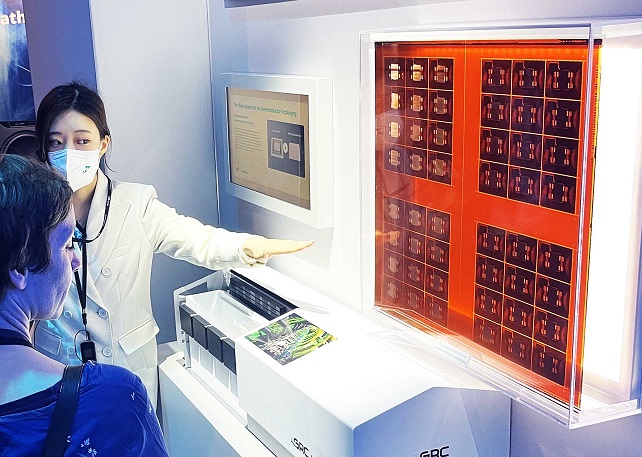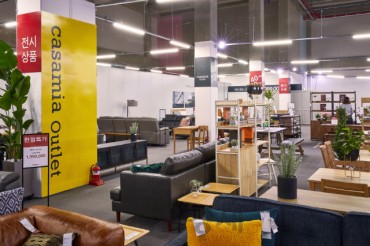
This photo, provided by SKC on Jan. 9, 2023, shows an aerial view of Absolics’ glass substrate production facility under construction in Covington, Georgia.
COVINGTON, Jan. 16 (Korea Bizwire) – The SKC campus, located about 56 kilometers east of Atlanta, is where the chemical materials unit of SK, South Korea’s energy-to-telecom conglomerate, built its first U.S. production facility in 1999 as a PET film developer.
More than two decades thereafter, SKC is building a new facility on the same site, seeking to become the first company to produce at scale a unique semiconductor packaging based on glass, considered an industrial breakthrough that potentially dispenses with plastic and silicon widely in use today.
The idea of using glass as a semiconductor substrate, a thin layer on which various chips are mounted to work as a core computing system, has been there for years, but SKC was the first to capitalize on the technology, Oh Joon-rok, CEO of Absolics Inc., SKC’s Georgia-based chip packaging subsidiary, said during a press tour on Jan. 9 (local time).
“It’s like the egg of Columbus. Who thinks of it first and pulls it off,” Oh said.
The concept had been developed and studied by the Packaging Research Center at Georgia Institute of Technology, with which SKC has maintained a long business-academic collaboration relationship.
As a Korean company, Oh said, SKC was familiar with highly advanced display and semiconductor component-making technologies possessed by South Korean companies and his team came up with the idea of bringing them to the glass substrate concept.
“We have commercialized the idea of integrating Georgia Tech’s proprietary glass technologies and the glass processing skills owned by Korean equipment manufacturers,” Oh said.
“We believe that, in the next 10 years, who has hegemony in the next-generation semiconductor packaging technology will decide the fate of that country as a semiconductor powerhouse or one that falls behind,” he said.

Oh Joon-rok, CEO of Absolics Inc., speaks during a press tour to the construction site for its glass substrate production facility, in Covington, Georgia, on Jan. 9, 2023, in this photo provided by SKC, the parent firm.
Since it launched the initial glass substrate development project in 2018, SKC has developed more than 200 processing technologies and related equipment tailored to the glass substrate manufacturing.
It has patented some 20 technologies with U.S. authorities.
Absolics’ glass substrate has a quarter thickness of the industry standard because it removes the silicon normally used as an intermediate layer in existing plastic substrates.
Its rigid but smooth surface allows a fine patterning on the chips and reduces the risks of warping cited as a problem in plastic substrates.
The multilayer ceramic capacitor (MLCC), a key chip component that controls the current’s flow in a circuit, will be embedded in the glass, creating more space to add more memory chips on the board and allowing the miniaturization of the packaging.
This also dramatically enhances power efficiency.
Such strengths make it ideal for advanced semiconductor applications involving high-performance computing, such as artificial intelligence, autonomous driving, high-speed telecommunications and large data centers, just to name a few.

This photo shows glass substrate sheets developed by Absolics Inc. being showcased at CES in Las Vegas from Jan. 5-8, in this photo provided by SKC on Jan. 9, 2023.
Absolics’ simulation on a Seoul-based data center, run by a major telecom company, found that the data throughput increased by eightfold when it used the glass substrates.
In November last year, Absolics broke ground in the same SKC campus, to build a glass substrate manufacturing facility under a planned US$600 million investment.
Absolics plans to build the first facility on a smaller volume by the end of this year and start mass production in the second quarter of next year.
The second facility, in a ramp-up to high-volume manufacturing, will be built over the next three to five years.
Under the plan, Absolics aims to produce 12,000 square meters of the glass substrates per year, and increase the production capacity to 72,000 square meters a year based on the high-volume manufacturing.
Once the mass production begins at a full scale, demand from global chipmakers is expected to overflow, Park Ho-seok, chief operating officer at Absolics, said.
“In terms of the high-volume manufacturing, we expect demand to surge by at least threefold to sixfold,” Park said.
Park said various tests have been under way with potential clients to customize the substrates, and the list, which he declined to name citing confidentiality agreement, includes “top-tier” chipmakers and some others that are military related.
Despite the gloomy outlook for the semiconductor market, the high-end semiconductor segment is forecast to grow at an annual 7 percent due to robust demand in high-performance computing, according to SKC.
And the semiconductor packaging for the high-performance computing sector is projected to expand at 13.4 percent annually.
“We hope that we can help create an ecosystem for the high-end semiconductor packaging and that South Korea will take the lead in the industry in the next decade,” Oh said.
“This will be yet another turning point.”
(Yonhap)






